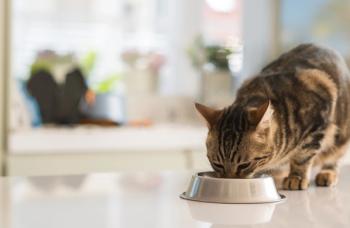
Case study: Iguana spay
Nebula is a 2-year-old 'axanthic blue' green iguana
When Nebula, 2-year-old 'axanthic blue' green iguana, entered the clinic on January 6, 2024, the patient had visible follicles and lab work was performed. Diagnostics showed unreadable hypercalcemia, hyperphosphatemia, and leukocytosis (34.5K). The patient would then go on to receive an ultrasound, which showed incompletely calcified follicles.
Nebula was moved into a reinforced cage able to withstand the weight of a nest box. The veterinary team provided nesting material that consisted of a 50/50 mixture of organic dirt mixed with Quikrete sand. Water was then added to the mixture until the material was able to retain a tunnel and calcium supplementation was increased. Nebula displayed some digging, but oviposition did not occur.
Nebula’s appetite began to gradually decrease as the eggs grew to the point that the patient eventually required syringe feeding of Oxbow Critical Care with 1/2 Extra Strength Tums, or 1 pinch of Arcadia Calcium Pro-Mg, to ensure adequate daily intake.
On January 30, 2024, the veterinary team rechecked the lab work and all values were similar except that the leukocytosis has decreased slightly to 33,800. The ultrasound and radiographs showed that patient had fully calcified eggs. Then, on February 21, 2024, radiographs were rechecked with no obvious changes and calcium (100 mg/kg IM diluted 1:1 with saline) was administered IM 1 hour prior to oxytocin (20 U/kg). At this time, the team noted that there was no laying behavior.
A second nesting box with different dirt, The Bio Dude Terra Sahara, was placed and a blanket was hung to give the patient privacy yet, there continued to be no nesting behavior. Calcium and oxytocin were then repeated every 8 hours for 2 days with no success. Given the change in season, ongoing inappetence, and loss of body condition, the team elected to perform an ovariohysterectomy.
Surgical procedure
Nebula, now a surgery patient, was placed in dorsal recumbency with the dorsal spines recessed into the V of the surgery table. A ventral paramedian incision was made through the scales, and the right ovary was elevated. Mosquito hemostats were used to make windows between vessels as well as combination of small and medium hemoclips were used. When placing a hemoclip by the right renal artery, the clip penetrated the artery. Pressure was held by the assisting student extern and 2 medium hemoclips were applied resolving the hemorrhage. The procedure was repeated on the left ovary with no complications. All visible reproductive tissue was removed, and a clot from the area of the renal artery puncture was removed from the coelom prior to closing also well. The team noted that there was no ongoing hemorrhage. The subcutaneous tissue was closed with simple continuous using 4-0 monoweb, avoiding the ventral abdominal vein and attempting to encourage eversion of tissue. Skin was closed with 35R staples continuing to evert tissue and a island bandage was placed over the incision and the patient was sent home on ceftazidime 30 mg/kg SQ q 72 hr x 10 d, meloxicam 0.15 mg/kg PO q 24 hr x 7 d, and tramadol ~ 5 mg/kg PO q 12 hr x 7 d.
Risks
Iguana spays have an inherent risk because of the close association of the ovary with the renal arteries. These patients also have a higher risk because of the amount of body mass that is lost while gravid. This patient was given longer to try and lay without going to surgery because the owner’s medical acumen and the fact that this was the patients first reproductive cycle.
Recovery
The patient’s recovery in hospital was slow, but the patient was able to move around and eat a small amount of critical care prior to leaving the hospital. The iguana’s enclosure had all bathing containers removed and dog beds were used to pad the bottom of the enclosure with towels on top for easy cleaning. Nebula was allowed access to perches to ensure adequate UV exposure/ POTZ maintenance. The patient began eating their favorite treat, rose petals, 7 hours after the operation and continued to eat small amounts daily. The iguana's preference in food changed from greens to softened commercial pelleted diets. The patient also received syringed critical care daily as a reward until oral medications were discontinued. The patient began resuming parkour-like antics after 6 days and their appetite remained moderately decreased for 5 weeks post-operation. Nebula’s bowel movement frequency and volume is still decreased at 6 weeks post operation.
The patient was allowed access to normal temperature regulated bathtub after 14 days. The patient began shedding sections of staples 10 days post-op and any staples that the patient did not shed will be removed 6 weeks post operation
Nebula’s bloodwork was rechecked 6 weeks post operation showing their calcium and phosphorous levels had returned to normal. Leukocytosis showed minimal improvement (32.7K), and new blood will be collected for culture/sensitivity once appropriate tubes are received. If the culture is negative, the leukocytosis will be monitored to establish seasonal patterns for the patient.
Sherri Edgar, DVM,CityVet, Las Colinas Owner, has a passion for reptile medicine, internal medicine, and pain management. She loves how every day is different and enjoys partnering with clients to provide the best care for their furry and scaly friends. She graduated from the University of Tennessee in 2014, and has an assortment of pets including a snake, iguanas, cats and dogs.
Newsletter
From exam room tips to practice management insights, get trusted veterinary news delivered straight to your inbox—subscribe to dvm360.






